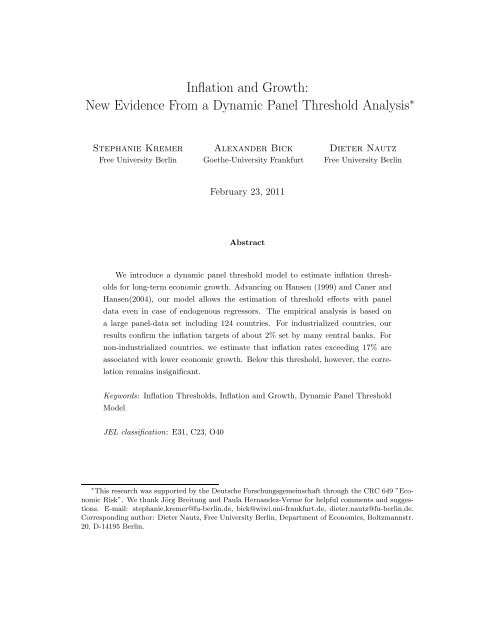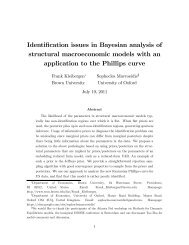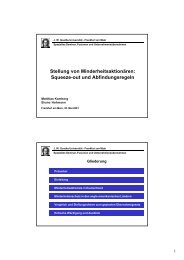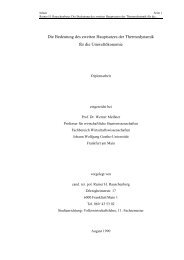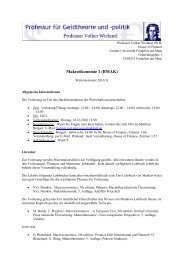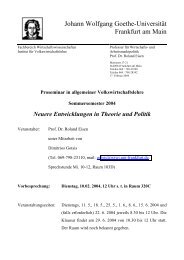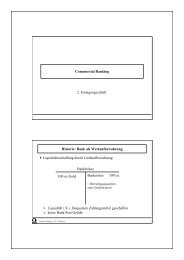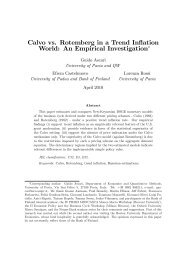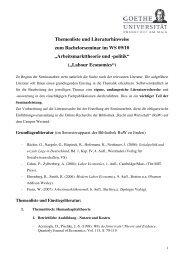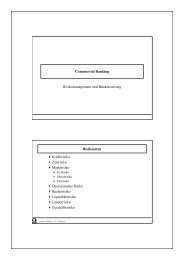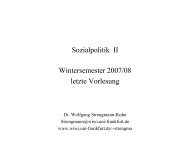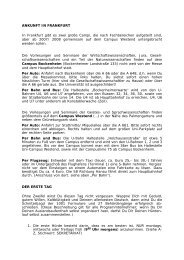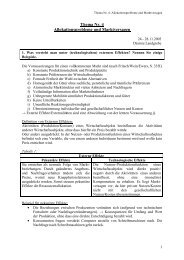Inflation and Growth: New Evidence From a Dynamic Panel ...
Inflation and Growth: New Evidence From a Dynamic Panel ...
Inflation and Growth: New Evidence From a Dynamic Panel ...
Create successful ePaper yourself
Turn your PDF publications into a flip-book with our unique Google optimized e-Paper software.
<strong>Inflation</strong> <strong>and</strong> <strong>Growth</strong>:<br />
<strong>New</strong> <strong>Evidence</strong> <strong>From</strong> a <strong>Dynamic</strong> <strong>Panel</strong> Threshold Analysis ∗<br />
Stephanie Kremer<br />
Free University Berlin<br />
Alex<strong>and</strong>er Bick<br />
Goethe-University Frankfurt<br />
February 23, 2011<br />
Abstract<br />
Dieter Nautz<br />
Free University Berlin<br />
We introduce a dynamic panel threshold model to estimate inflation thresh-<br />
olds for long-term economic growth. Advancing on Hansen (1999) <strong>and</strong> Caner <strong>and</strong><br />
Hansen(2004), our model allows the estimation of threshold effects with panel<br />
data even in case of endogenous regressors. The empirical analysis is based on<br />
a large panel-data set including 124 countries. For industrialized countries, our<br />
results confirm the inflation targets of about 2% set by many central banks. For<br />
non-industrialized countries, we estimate that inflation rates exceeding 17% are<br />
associated with lower economic growth. Below this threshold, however, the corre-<br />
lation remains insignificant.<br />
Keywords: <strong>Inflation</strong> Thresholds, <strong>Inflation</strong> <strong>and</strong> <strong>Growth</strong>, <strong>Dynamic</strong> <strong>Panel</strong> Threshold<br />
Model<br />
JEL classification: E31, C23, O40<br />
∗ This research was supported by the Deutsche Forschungsgemeinschaft through the CRC 649 ”Economic<br />
Risk”. We thank Jörg Breitung <strong>and</strong> Paula Hern<strong>and</strong>ez-Verme for helpful comments <strong>and</strong> suggestions.<br />
E-mail: stephanie.kremer@fu-berlin.de, bick@wiwi.uni-frankfurt.de, dieter.nautz@fu-berlin.de.<br />
Corresponding author: Dieter Nautz, Free University Berlin, Department of Economics, Boltzmannstr.<br />
20, D-14195 Berlin.
1 Introduction<br />
Most economists would agree that inflation has distortional effects on long-term eco-<br />
nomic growth if it gets “too high”. Yet how high is too high? In the aftermath of the<br />
recent financial crisis, the long-time consensus on inflation targets for industrialized<br />
countries centering around 2% has been put up for discussion. Following e.g. Blan-<br />
chard, DellAriccia <strong>and</strong> Mauro (2010), the effects of inflation on growth are difficult to<br />
discern, so long as inflation remains in the single digits. As a consequence, they suggest<br />
that an inflation target of 4% might be more appropriate because it leaves more room<br />
for expansionary monetary policy in case of adverse shocks. For developing countries,<br />
the appropriate level of the inflation target is also unclear. Bruno <strong>and</strong> Easterly (1998),<br />
for example, showed in a cross-sectional setting that inflation has only a detrimental<br />
impact on long-term economic growth if inflation exceeds a critical level of 40% — a<br />
rather large value which may be of only of limited relevance for monetary policy of<br />
many countries. 1<br />
The theoretical literature offers various channels through which inflation may distort or<br />
even foster economic growth, see Temple (2000). If these different channels overlap or<br />
offset each other, or unfoldan economic meaningful impact only for certain ranges of in-<br />
flation, the relationship between inflation <strong>and</strong> economic growth might be characterized<br />
by inflation thresholds, see Vaona (2010). 2 A natural starting point for the empiri-<br />
cal analysis of inflation thresholds is the panel threshold model introduced by Hansen<br />
(1999) which is designed to estimate threshold values instead of imposing them. Yet,<br />
the application of Hansen’s threshold model to the empirical analysis of the inflation-<br />
growth nexus is not without problems. The most important limitation of Hansen’s<br />
1 For example, the Southern African Development Community (SADC) convergence criteria requires<br />
a low single digit inflation rate, see Regional Indicative Strategic Development Plan available<br />
at http://www.sadc.int/attachment/download/file/74. Recent empirical work by Goncalves <strong>and</strong><br />
Salles (2008) <strong>and</strong> Lin <strong>and</strong> Ye (2009) suggests that inflation targeting in developing countries can lead<br />
to significant improvements in terms of inflation <strong>and</strong> output volatility.<br />
2 Similar non-linear effects of inflation have been documented by Bick <strong>and</strong> Nautz (2008) for relative<br />
price variability in the US <strong>and</strong> by Khan, Senhadji <strong>and</strong> Smith (2006) for financial depth in a large<br />
cross-country panel data set.<br />
1
model is that all regressors are required to be exogenous. In growth regressions with<br />
panel data, the exogeneity assumption is particular severe, because initial income as<br />
a crucial variable is endogenous by construction. Caselli, Esquivel <strong>and</strong> Lefort (1996)<br />
already demonstrated for linear panel models of economic growth that the endogeneity<br />
bias can be substantial. So far, dynamic versions of Hansen’s panel threshold model<br />
have not been available. Therefore, with a view to the central role of initial income<br />
for the convergence debate of the economic growth literature, most empirical stud-<br />
ies on growth-related thresholds applying the Hansen methodology decided to ignore<br />
the potential endogeneity bias, see Khan <strong>and</strong> Senhadji (2001), Cuaresma <strong>and</strong> Silgo-<br />
ner (2004), Foster (2006) <strong>and</strong> Bick (2010). In contrast, Drukker, Gomis-Porqueras <strong>and</strong><br />
Hern<strong>and</strong>ez-Verme (2005) excluded initial income from their growth regressions to avoid<br />
the endogeneity problem. Both ways to deal with the endogeneity of initial income can<br />
lead to biased estimates of the inflation thresholds <strong>and</strong> to misleading conclusions about<br />
the impact of inflation on growth in the corresponding inflation regimes. 3<br />
This paper introduces a dynamic version of Hansen’s panel threshold model to shed<br />
more light on the inflation-growth nexus. By applying the forward orthogonal devia-<br />
tions transformation suggested by Arellano <strong>and</strong> Bover (1995), we combine the instru-<br />
mental variable estimation of the cross-sectional threshold model introduced by Caner<br />
<strong>and</strong> Hansen (2004) with the panel threshold model of Hansen (1999). In the dynamic<br />
model, the endogeneity of important control variables is no longer an issue. This per-<br />
mits us to estimate the critical level of inflation for economic growth for industrialized<br />
<strong>and</strong> non-industrialized countries albeit the endogeneity problem of initial income.<br />
Our empirical results strongly confirm earlier evidence in favor of inflation thresholds in<br />
the inflation-growth nexus. In accordance with Khan <strong>and</strong> Senhadji (2001), we find no-<br />
table differences between the results obtained for industrialized <strong>and</strong> non-industrialized<br />
countries. For industrialized countries, the estimated inflation threshold is about 2.5%<br />
3 Note that alternative approaches toestimate a non-linear relationship between inflation <strong>and</strong> growth<br />
face the same problem: they either exclude initial income (Omay <strong>and</strong> Kan, 2010) or do not control<br />
for its endogeneity (Burdekin, Denzau, Keil, Sitthiyot <strong>and</strong> Willet, 2004; Hineline, 2007; Vaona <strong>and</strong><br />
Schiavo, 2007).<br />
2
which provides strong support for the inflation targets of many central banks. In par-<br />
ticular, inflation rates below/above 2.5% are associated with higher/lower long-term<br />
economic growth in industrialized countries. For developing countries, the estimated<br />
inflation threshold is 17.2%. <strong>Inflation</strong> rates exceeding this critical value, i.e. if it gets<br />
“too high”, come along with significantly lower economic growth with a magnitude<br />
similar to industrialized countries. In contrast, there is no significant association be-<br />
tween inflation <strong>and</strong> long-term economic growth in developing countries when inflation<br />
is below 17.2%.<br />
Given the lack of a st<strong>and</strong>ard theory on the relationship between inflation <strong>and</strong> long-<br />
term economic growth, our empirical results on the inflation-growth nexus have to be<br />
interpreted with caution. Strictly speaking, our estimates may only reflect correlations<br />
<strong>and</strong> do not necessarily imply causality from inflation to growth. Yet, reduced form<br />
estimates may still serve as a benchmark <strong>and</strong> a first guideline for the discussion on the<br />
optimal level of inflation targets.<br />
Therestofthepaperisorganizedasfollows. InSection2, wediscusstheeconometrics of<br />
the dynamic panel threshold model. Section 3 introduces the data <strong>and</strong> the control vari-<br />
ables employed in our empirical application. In Section 4 the dynamic panel threshold<br />
model is applied to the inflation-growth nexus in industrialized <strong>and</strong> non-industrialized<br />
countries. Section 5 concludes.<br />
2 A <strong>Dynamic</strong> <strong>Panel</strong> Threshold Model<br />
2.1 The Econometric Model<br />
This section develops a dynamic panel threshold model that extends Hansen’s (1999)<br />
original static set up by endogenous regressors. In our empirical application where we<br />
analyze the role of inflation thresholds in the relationship between inflation <strong>and</strong> eco-<br />
nomic growth (yit = dgpdit), the endogenous regressor will be initial income (gdpit−1).<br />
Ourmodelextension buildson thecross-sectional thresholdmodelof Caner<strong>and</strong> Hansen<br />
3
(2004) where GMM type estimators are used in order to allow for endogeneity. To that<br />
aim, consider the following panel threshold model<br />
yit = µi +β1zitI(qit ≤ γ)+β2zitI(qit > γ)+εit, (1)<br />
where subscripts i = 1,...,N represents the country <strong>and</strong> t = 1,...,T indexes time.<br />
µi is the country specific fixed effect <strong>and</strong> the error term is εit iid<br />
∼ (0,σ 2 ). I(·) is the<br />
indicator function indicating the regime defined by the threshold variable qit <strong>and</strong> the<br />
threshold level γ. zit is a m-dimensional vector of explanatory regressors which may<br />
include lagged values of y <strong>and</strong> other endogenous variables. The vector of explanatory<br />
variables is partitioned into a subset z1it, of exogenous variables uncorrelated with<br />
εit, <strong>and</strong> a subset of endogenous variables z2it, correlated with εit. In addition to the<br />
structuralequation(1)themodelrequiresasuitablesetofk ≥ minstrumentalvariables<br />
xit including z1it.<br />
2.2 Fixed-Effects Elimination<br />
In the first step of the estimation procedure, one has to eliminate the individual effects<br />
µi via a fixed-effects transformation. The main challenge is to transform the panel<br />
threshold model in a way that eliminates the country-specific fixed effects without vio-<br />
lating the distributional assumptions underlying Hansen (1999) <strong>and</strong> Caner <strong>and</strong> Hansen<br />
(2004), compare Hansen (2000). In the dynamic model (1), the st<strong>and</strong>ard within trans-<br />
formation applied by Hansen (1999) leads to inconsistent estimates because the lagged<br />
dependent variable will always be correlated with the mean of the individual errors <strong>and</strong><br />
thus all of the transformed individual errors. First-differencing of the dynamic equation<br />
(1) as usually done in the context of dynamic panels implies negative serial correlation<br />
of the error terms such that the distribution theory developed by Hansen (1999) is not<br />
applicable anymore to panel data. 4<br />
4 Note that in Hansen (1999) the within-transformation also implies negative serial correlation of the<br />
transformed error terms. However, this is not a problem because of the idempotency of the transformed<br />
error matrix, see Equation A.12 Hansen (1999, p366).<br />
4
In view of these problems, we consider the forward orthogonal deviations transfor-<br />
mation suggested by Arellano <strong>and</strong> Bover (1995) to eliminate the fixed effects. 5 The<br />
distinguishing feature of the forward orthogonal deviations transformation is that se-<br />
rial correlation of the transformed error terms is avoided. Instead of subtracting the<br />
previous observation from the contemporaneous one (first-differencing) or the mean<br />
from each observation (within transformation), it subtracts the average of all future<br />
available observations of a variable. Thus, for the error term, the forward orthogonal<br />
deviations transformation is given by:<br />
ε ∗ it =<br />
�<br />
T −t<br />
T −t+1 [εit − 1<br />
T −t (εi(t+1) +...+εiT)]. (2)<br />
Therefore, the forward orthogonal deviation transformation maintains the uncorrelat-<br />
edness of the error terms, i.e.<br />
Var(εi) = σ 2 IT ⇒ Var(ε ∗ i ) = σ2 IT−1.<br />
In accordance with Hansen (2000), this ensures that the estimation procedure derived<br />
by Caner <strong>and</strong> Hansen (2004) for a cross-sectional model can be applied to the dynamic<br />
panel equation (1).<br />
2.3 Estimation<br />
Following Caner <strong>and</strong> Hansen (2004), we estimate a reduced form regression for the<br />
endogeneous variables, z2it, as a function of the instruments xit. The endogenous<br />
variables, z2it, are then replaced in the structural equation by the predicted values ˆz2it.<br />
In step two, equation (1) is estimated via least squares for a fixed threshold γ where<br />
the z2i’s are replaced by their predicted values from the first step regression. Denote<br />
the resulting sum of squared residuals by S(γ). This step is repeated for a strict subset<br />
of the support of the threshold variable q from which in a third step the estimator of<br />
the threshold value γ is selected as the one associated with the smallest sum of squared<br />
residuals, i.e. ˆγ = argmin<br />
γ<br />
Sn(γ).<br />
5 We are grateful to Jörg Breitung for this suggestion.<br />
5
In accordance with Hansen (1999) <strong>and</strong> Caner <strong>and</strong> Hansen (2004), the critical values for<br />
determining the 95% confidence interval of the threshold value are given by<br />
Γ = {γ : LR(γ) ≤ C(α)},<br />
where C(α) is the 95% percentile of the asymptotic distribution of the likelihood ratio<br />
statistic LR(γ). The underlying likelihood ratio has been adjusted to account for<br />
the number of time periods used for each cross section, see Hansen (1999). Once<br />
ˆγ is determined, the slope coefficients can be estimated by the generalized method<br />
of moments (GMM) for the previously used instruments <strong>and</strong> the previous estimated<br />
threshold ˆγ.<br />
3 Data <strong>and</strong> Variables<br />
Our empirical application of the dynamic panel threshold model to the inflation-growth<br />
nexusisbasedonanunbalancedpanel-datasetof124countries. Industrialized<strong>and</strong>non-<br />
industrialized countries are identified in accordance with the International Financial<br />
Statistics (IFS) <strong>and</strong> shown in Tables 3 <strong>and</strong> 4 in the Appendix A.1. Using data from<br />
1950 to 2004 we extend the samples by Khan <strong>and</strong> Senhadji (2001) (1960 to 1998) <strong>and</strong><br />
Drukker et al. (2005) (1950 to 2000). As a consequence, our sample contains more<br />
information about the growth effects of low inflation.<br />
For each country, annual growth rates of real GDP per capita in constant 2000 prices<br />
(dgdp) are obtained from Penn World Table 6.2. <strong>Inflation</strong> is computed as the annual<br />
percentage change of the Consumer Price Index (π) collected from IFS. In line with<br />
the empirical growth literature, our results on the determinants of long-term economic<br />
growth will be based on five-year averages which gives us 988 observations, 227 for<br />
industrialized <strong>and</strong> 761 for non-industrialized countries.<br />
6
3.1 Control Variables<br />
Any empirical analysis of inflation’s impact on economic growth has to control for the<br />
influence of other economic variables that are correlated with the rate of inflation.<br />
Following Khan <strong>and</strong> Senhadji (2001) <strong>and</strong> Drukker et al. (2005), we consider the per-<br />
centage of GDP dedicated to investment (igdp), the population growth rate (dpop), the<br />
initial income level (initial) measured as GDP per capita from the previous period <strong>and</strong><br />
openness (open) measured as the logged share of exports plus imports in GDP. These<br />
variables are obtained from Penn World Table 6.2. The annual percentage change in<br />
the terms of trade (dtot) is measuredas exports divided by imports. Export <strong>and</strong> import<br />
data are taken from Penn World Table 6.1 until 2000 <strong>and</strong> for the later years from the<br />
World Trade Organization (WTO) database. We also included the st<strong>and</strong>ard deviations<br />
of the terms of trade (sdtot) <strong>and</strong> of openness (sdopen). More information about the<br />
control variables is contained in Table 2 in the Appendix. All these variables passed<br />
the robustness tests of Levine <strong>and</strong> Renelt (1992) <strong>and</strong> Sala-i-Martin (1997).<br />
3.2 <strong>Inflation</strong><br />
<strong>Inflation</strong> has been lower in industrialized countries with an average annual inflation rate<br />
over the sample period of 5.86% as opposed to 33.63% for non-industrialized countries.<br />
For both set of countries, the dispersion of inflation rates is considerable, see Figures<br />
1 <strong>and</strong> 3 in the Appendix A.2. In this case, Ghosh <strong>and</strong> Phillips (1998) strongly suggest<br />
the use of logged inflation rates to avoid that regression results are distorted by a few<br />
extreme inflation observations. Moreover, using logged inflation rates has the plausible<br />
implication that multiplicative, not additive, inflation shocks will have identical growth<br />
effects. Since our sample contains negative inflation rates, we follow Drukker et al.<br />
(2005) <strong>and</strong> Khan <strong>and</strong> Senhadji (2001) by employing a semi-log transformation of the<br />
inflation rate πit<br />
˜πit =<br />
⎧<br />
⎪⎨<br />
πit −1, if πit ≤ 1<br />
⎪⎩ ln(πit), if πit > 1,<br />
7
where inflation rates below one are re-scaled for sake of continuity. In sharp contrast to<br />
thehighly skewed <strong>and</strong>leptokurtic inflation dataof industrialized<strong>and</strong> non-industrialized<br />
countries, the distributions of semi-logged inflation rates are much more symmetric <strong>and</strong><br />
in line with the normal distribution, see Figures 2 <strong>and</strong> 4 in Appendix A.2.<br />
4 <strong>Inflation</strong> Thresholds <strong>and</strong> <strong>Growth</strong><br />
Let us now apply the dynamicpanel thresholdmodel to the analysis of the impact of in-<br />
flation onlong-term economicgrowth inindustrialized <strong>and</strong>non-industrializedcountries.<br />
To that aim, consider the following threshold model of the inflation-growth nexus:<br />
dgdpit = µi +β1˜πitI(˜πit ≤ γ)+δ1I(˜πit ≤ γ)+β2˜πitI(˜πit > γ)+φzit +εit. (3)<br />
Inourapplication, inflation ˜πit is both, thethresholdvariable<strong>and</strong>theregimedependent<br />
regressor. zit denotes the vector of partly endogenous control variables, where slope<br />
coefficients are assumed to be regime independent. Following Bick (2010), we allow<br />
for differences in the regime intercepts (δ1). 6 Initial income is considered as endoge-<br />
nous variable, i.e. z2it = initialit = gdpit−1, while z1it contains the remaining control<br />
variables. 7<br />
Following Arellano <strong>and</strong> Bover (1995), we use lags of the dependent variable<br />
(dgdpit−1,...,dgdpit−p) as instruments. Empirical results may depend on the num-<br />
ber (p) of instruments, see Roodman (2009). In particular, there is a bias/efficiency<br />
trade-off in finite samples. Therefore, we considered two empirical benchmark specifi-<br />
cations. On the one h<strong>and</strong>, we use all available lags of the instrument variable (p = t)<br />
to increase efficiency, see Table 1. On the other h<strong>and</strong>, we reduced the instrument count<br />
to one (p = 1) to avoid an overfit of instrumented variables that might lead to biased<br />
coefficient estimates. According to Table 5 in the Appendix, the choice of instruments<br />
has no important impact on our results.<br />
6 Including time dummies in Equation (3) will not change our main results.<br />
7 The empirical model could be easily extended by allowing for the endogeneity of further control<br />
variables. In our application, however, st<strong>and</strong>ard Hausman tests indicate that the endogeneity of the<br />
8
Threshold estimates<br />
Table 1: <strong>Inflation</strong> thresholds <strong>and</strong> growth<br />
Industrialized Non-Industrialized<br />
Countries Countries<br />
�γ 2.530% 17.228%<br />
95% confidence interval [1.94, 2.76] [12.85, 19.11]<br />
Impact of inflation<br />
�β1<br />
�β2<br />
Impact of covariates<br />
initialit<br />
igdpit<br />
dpopit<br />
dtotit<br />
sdtotit<br />
openit<br />
sdopenit<br />
�δ1<br />
1.374∗∗∗ (0.436)<br />
−0.391∗ (0.220)<br />
−1.371<br />
(0.950)<br />
0.107 ∗∗∗<br />
(0.036)<br />
0.290<br />
(0.341)<br />
−0.162 ∗∗∗<br />
(0.036)<br />
−0.036<br />
(0.041)<br />
−0.882<br />
(1.080)<br />
0.426 ∗∗<br />
(0.213)<br />
−0.384<br />
(0.511)<br />
−0.121<br />
(0.117)<br />
−0.434 ∗∗<br />
(0.222)<br />
−1.800 ∗∗<br />
(0.858)<br />
0.157 ∗∗∗<br />
(0.045)<br />
−0.503 ∗∗<br />
(0.257)<br />
−0.072 ∗∗∗<br />
(0.025)<br />
−0.007<br />
(0.020)<br />
0.768<br />
(0.640)<br />
0.046<br />
(0.169)<br />
0.745<br />
(1.077)<br />
Observations 227 761<br />
N 23 101<br />
Notes: This Table reports results for the dynamic panel threshold estimation as<br />
described in Section 2 using all available lags of the instrument variable, i.e.<br />
{dgdpit−1, dgdpit−2, ...,dgdpi0}. Following Hansen (1999), each regime contains at least<br />
5% of all observations. For industrialized countries, feasible inflation thresholds are, therefore,<br />
between 1.146 <strong>and</strong> 15.668% <strong>and</strong> for non-industrialized countries between 1.002 <strong>and</strong><br />
66.146%. St<strong>and</strong>ard errors are given in parentheses.<br />
9
Table 1 shows the results obtained for industrialized <strong>and</strong> non-industrialized countries.<br />
The upper part of the table displays the estimated inflation threshold <strong>and</strong> the cor-<br />
responding 95% confidence interval. The middle part shows the regime-dependent<br />
coefficients of inflation on growth. Specifically, � β1 ( � β2) denotes the marginal effect<br />
of inflation on growth in the low (high) inflation regime, i.e. when inflation is below<br />
(above) the estimated threshold value. The coefficients of the control variables are<br />
presented in the lower part of the table.<br />
4.1 The <strong>Inflation</strong>-<strong>Growth</strong> Nexus in Industrialized Countries<br />
The results for the empirical relation between inflation <strong>and</strong> growth in industrialized<br />
countries based on the first benchmark specification are presented in the first column<br />
of Table 1. The estimated inflation threshold of 2.53% as well as the marginal ef-<br />
fects of inflation on growth strongly support the prevailing inflation targets of many<br />
central banks. First, the 95% confidence interval ([1.94, 2.76]) of the threshold value<br />
includes 2% but does not contain 4%, the alternative inflation target recently suggested<br />
by Blanchard et al. (2010). Second, both regime-dependent coefficients of inflation are<br />
significant <strong>and</strong> plausibly signed. <strong>Inflation</strong> is positively correlated with economic growth<br />
in industrialized countries if above the threshold ( � β1 = 1.37), while the opposite is true<br />
for higher inflation ( � β2 = −0.391). The absolute size of the inflation coefficients suggest<br />
that correlation between inflation <strong>and</strong> economic growth of industrialized countries is<br />
stronger when inflation is low. According to the 95% confidence intervals, this conclu-<br />
sion holds at least for inflation rates ”below but close to 2%”.<br />
It is worth emphasizing that our results are robust with respect to the choice of instru-<br />
ments, seeTable 5 in the Appendix. Theonly notable exception refers to theconfidence<br />
interval of the inflation threshold. If the instrument count is reduced to one, estima-<br />
tion is less efficient <strong>and</strong> the 95% confidence interval of the inflation threshold widens to<br />
[1.38, 5.50]. As a consequence, the evidence on the long-run growth effects of inflation<br />
remaining control variables is not an issue. Results of Hausman tests are not presented but are available<br />
on request.<br />
10
ates around 4% must be viewed with caution.<br />
4.2 The <strong>Inflation</strong>-<strong>Growth</strong> Nexus in Non-Industrialized Countries<br />
The results for non-industrialized countries are shown in the second column of Ta-<br />
ble 1. They differ from those obtained for industrialized countries in two important<br />
aspects. First, the estimated threshold level of inflation (17.2%) is definitely higher<br />
than in industrialized countries. The 95% confidence interval indicates that the crit-<br />
ical value of inflation for non-industrialized countries is clearly lower than the 40%<br />
proposed by Bruno <strong>and</strong> Easterly (1998). According to our estimates, even inflation<br />
rates above 12.85% may already be seen as “too high”. The higher inflation threshold<br />
for non-industrialized countries could be explained by the widespread use of index-<br />
ation systems, which many non-industrialized countries have adopted due to a long<br />
history of inflation. These indexation systems may partially reduce the adverse ef-<br />
fects of inflation. Following e.g. Khan <strong>and</strong> Senhadji (2001), higher inflation thresholds<br />
in non-industrialized countries may also be related to a convergence process <strong>and</strong> the<br />
Balassa-Samuelson effect. The coefficient of inflation ( � β2=-0.434) is significant <strong>and</strong><br />
plausibly signed when inflation gets above its threshold. Therefore we find clear ev-<br />
idence suggesting that high inflation rates in non-industrialized countries come along<br />
with lower growth rates. 8<br />
The second important difference between the empirical results obtained for industri-<br />
alized <strong>and</strong> non-industrialized countries refers to the correlation between growth <strong>and</strong><br />
inflation when inflation is below its threshold. While the inflation coefficient in indus-<br />
trial countries has been significant for low inflation rates <strong>and</strong> large in absolute terms<br />
relative to high inflation, this is not true for the low-inflation regime in developing<br />
countries. The corresponding estimate, � β1 = −0.12, is small <strong>and</strong> far from significant<br />
for non-industrialized countries.<br />
For non-industrialized countries, the effect of the instrument variables on the estimated<br />
8 By contrast, Drukker et al. (2005) find significant inflation thresholds but no significant impact of<br />
inflation on growth in any regime.<br />
11
inflation thresholds is negligible, see Table 5. The reduction of the instrument count<br />
only affects the estimates for the control variables where the st<strong>and</strong>ard errors slightly<br />
increase.<br />
Finally, it is worth noting that our results on the empirical inflation-growth nexus ob-<br />
tained from a dynamic panel threshold model broadly confirm earlier findings based on<br />
modelsthat shouldhave sufferedfromanendogeneity bias, compareKhan<strong>and</strong>Senhadji<br />
(2001) <strong>and</strong> Bick (2010). Apparently, in our application accounting for the endogeneity<br />
of control variables does not have a major impact on the estimated thresholds. In<br />
other application, however, avoiding the endogeneity bias in a panel threshold model<br />
may lead to very different conclusions.<br />
5 Concluding Remarks<br />
This paper provided new evidence on the non-linear relationship between inflation <strong>and</strong><br />
long-term economic growth. To that aim, we built on Hansen (1999) <strong>and</strong> Caner <strong>and</strong><br />
Hansen (2004) <strong>and</strong> developed a dynamic threshold model that allows for endogeneous<br />
regressors in a panel setup. Applying the forward orthogonal deviations transformation<br />
suggested by Arellano <strong>and</strong> Bover (1995) ensured that the original distribution theory<br />
of the threshold model applied to static panels as in Hansen (1999) is still valid in a<br />
dynamic context.<br />
Applying the dynamic panel threshold model to the analysis of thresholds in the<br />
inflation-growth nexus, confirmed the general consensus among economists. In par-<br />
ticular, our empirical results suggest that inflation distorts economic growth provided<br />
it exceeds a certain critical value. However, there are important differences for indus-<br />
trialized <strong>and</strong> non-industrialized countries concerning both the level of the estimated<br />
inflation threshold <strong>and</strong> the impact of inflation in the various inflation regimes.<br />
For industrialized countries, our results support the inflation targets of about 2% which<br />
are more or less explicitly announced by many central banks. Contributing to the<br />
recent discussion on the appropriate level of inflation targets stirred by Blanchard<br />
12
et al. (2010), we estimated that inflation rates exceeding a critical value of 2.5% are<br />
positively correlated with economic growth while the opposite is true below that level.<br />
Fornon-industrializedcountries, theestimatedinflationthresholdismuchhigher, about<br />
17%. <strong>Inflation</strong> rates above this threshold come along with significantly lower growth<br />
rates for non-industrialized countries but not vice versa. Thus, our results do not<br />
support growth-enhancing effects of moderate inflation rates below the threshold value.<br />
However, policy conclusions based on reduced form estimates have to be viewed with<br />
caution. In particular, the estimated inflation-growth nexus does not necessarily reflect<br />
causality but rather correlation. Yet, significant inflation thresholds in the empirical<br />
relationship between inflation <strong>and</strong> growth may provide a useful guideline for further<br />
research on the impact of inflation on growth.<br />
The empirical setup of the current study controlled for the effect of further variables on<br />
growth but assumed that the level of the inflation threshold only depends on whether a<br />
country is industrialized or not. In particular for the very heterogenous group of non-<br />
industrialized countries, this assumption may be too restrictive. Lin <strong>and</strong> Ye (2009),<br />
for example, show that the performance of inflation targeting in developing countries<br />
can be affected by further country characteristics. Accordingly, inflation thresholds in<br />
developing countries <strong>and</strong>, thus, the appropriate level of the inflation target might be<br />
also country-specific. The identification of country-specific inflation thresholds in the<br />
inflation-growth nexus might provide useful information about the appropriate location<br />
<strong>and</strong> width of an inflation targeting b<strong>and</strong>. We leave this extension of our analysis for<br />
future research.<br />
References<br />
Arellano, M. <strong>and</strong> Bover, O. (1995). Another look at the instrumental variables estima-<br />
tion of error-components models, Journal of Econometrics 68: 29–51.<br />
Bick, A. (2010). Threshold Effects of <strong>Inflation</strong> on Economic <strong>Growth</strong> in Developing<br />
Countries, Economics Letters 108(2): 126–129.<br />
13
Bick, A. <strong>and</strong> Nautz, D. (2008). <strong>Inflation</strong> Thresholds <strong>and</strong> Relative Price Variability:<br />
<strong>Evidence</strong> from U.S. Cities, International Journal of Central Banking 4(3): 61–76.<br />
Blanchard, O., DellAriccia, G. <strong>and</strong> Mauro, P. (2010). Rethinking Macroeconomic Pol-<br />
icy, IMF Staff Position Note SPN/10/03.<br />
Bruno, M. <strong>and</strong> Easterly, W. (1998). <strong>Inflation</strong> Crisis <strong>and</strong> Long-Run <strong>Growth</strong>, Journal of<br />
Monetary Economics 41: 3–26.<br />
Burdekin, R. C., Denzau, A. T., Keil, M. W., Sitthiyot, T. <strong>and</strong> Willet, T. D. (2004).<br />
When does inflation hurt economic growth? Different nonlinearities for different<br />
economies, Journal of Macroeconomics pp. 519–532.<br />
Caner, M. <strong>and</strong> Hansen, B. E. (2004). Instrumental Variable Estimation of a Threshold<br />
Model, Econometric Theory 20: 813–843.<br />
Caselli, F., Esquivel, G. <strong>and</strong> Lefort, F. (1996). Reopening the Convergence Debate:<br />
A <strong>New</strong> Look at Cross-Country <strong>Growth</strong> Empirics, Journal of Economic <strong>Growth</strong><br />
1(3): 363–389.<br />
Cuaresma, J. C. <strong>and</strong> Silgoner, M. A. (2004). <strong>Growth</strong> Effects of <strong>Inflation</strong> in Europe:<br />
How low is too low, how high is too high?, Working Paper University of Vienna .<br />
Drukker, D., Gomis-Porqueras, P. <strong>and</strong> Hern<strong>and</strong>ez-Verme, P. (2005). Threshold Effects<br />
in the Relationship Between <strong>Inflation</strong> <strong>and</strong> <strong>Growth</strong>: A <strong>New</strong> <strong>Panel</strong>-Data Approach,<br />
Working Paper .<br />
Foster, N. (2006). Exports, <strong>Growth</strong> <strong>and</strong> Threshold Effects in Africa, Journal of Devel-<br />
opment Studies 42(6): 1056–1074.<br />
Ghosh, A. <strong>and</strong>Phillips, S. (1998). Warning: <strong>Inflation</strong> May BeHarmful to Your <strong>Growth</strong>,<br />
IMF Staff Papers 45(4): 672–710.<br />
Goncalves, C. E. S. <strong>and</strong> Salles, J. M. (2008). <strong>Inflation</strong> targeting in emerging economies:<br />
What do the data say?, Journal of Development Economics 85: 312–318.<br />
14
Hansen, B. E. (1999). Threshold Effects in Non-<strong>Dynamic</strong> <strong>Panel</strong>s: Estimation, Testing,<br />
<strong>and</strong> Inference, Journal of Econometrics 93: 345–368.<br />
Hansen, B. E. (2000). Sample Splitting <strong>and</strong> Threshold Estimation, Econometrica<br />
68(3): 575–603.<br />
Hineline, D. R. (2007). Examining the Robustness of the <strong>Inflation</strong> <strong>and</strong> <strong>Growth</strong> Rela-<br />
tionship, Southern Economic Journal 73(4): 1020–1037.<br />
Khan, M. S. <strong>and</strong> Senhadji, A. S. (2001). Threshold effects in the Relationship between<br />
<strong>Inflation</strong> <strong>and</strong> <strong>Growth</strong>, IMF Staff Papers 48.<br />
Khan, M. S., Senhadji, A. S. <strong>and</strong> Smith, B. D. (2006). <strong>Inflation</strong> <strong>and</strong> Financial Depth,<br />
Macroeconomic <strong>Dynamic</strong>s, pp. 1–18.<br />
Levine, R. <strong>and</strong> Renelt, D. (1992). A Sensitivity Analysis of Cross-Country <strong>Growth</strong><br />
Regressions, American Economic Review 82(4): 942–963.<br />
Lin, S. <strong>and</strong> Ye, H. (2009). Does <strong>Inflation</strong> Targeting Make a Difference in Developing<br />
Countries?, Journal of Development Economics 89: 118–123.<br />
Omay, T. <strong>and</strong> Kan, E. O. (2010). Re-examining the threshold effects in the inflation-<br />
growth nexuswith cross-sectionally dependent non-linear panel: <strong>Evidence</strong> from six<br />
industrialized economies, Economic Modelling Forthcoming.<br />
Roodman, D. (2009). A Note on the Theme of Too Many Instruments, Oxford Bulletin<br />
of Economics <strong>and</strong> Statistics 71(1): 135–158.<br />
Sala-i-Martin, X. (1997). I just ran two million regressions, American Economic Review<br />
87: 178–183.<br />
Temple, J. (2000). <strong>Inflation</strong> <strong>and</strong> <strong>Growth</strong>: Stories Short <strong>and</strong> Tall, Journal of Economic<br />
Surveys 14(4): 397–426.<br />
Vaona, A. (2010). <strong>Inflation</strong> <strong>and</strong> <strong>Growth</strong> in the Long Run: A <strong>New</strong> Keynesian Theory<br />
<strong>and</strong> Further Semiparametric <strong>Evidence</strong>, Macroeconomic <strong>Dynamic</strong>s Forthcoming.<br />
15
Vaona, A. <strong>and</strong> Schiavo, S. (2007). Nonparametric <strong>and</strong> semiparametric evidence on the<br />
long-run effects of inflation on growth, Economics Letters 94: 452–458.<br />
16
A Appendix<br />
A.1 Tables<br />
Table 2: List of Variables<br />
dgdp Five-year average of the annual growth rate of real GDP per capita<br />
in constant 2000 prices<br />
dpop Five-year average of the annual growth rate of population<br />
dtot Five-year average of the annual percentage change in the terms of trade,<br />
where the terms of trade are measured as exports divided by imports<br />
igdp Five-year average of the annual percentage of GDP dedicated to investment<br />
initial Five-year average of GDP per capita in 2000 constant prices,<br />
from the previous period, in logs<br />
open Five-year average of log of openness,<br />
where openness is measured as the share of exports plus imports in the GDP<br />
π Five-year average of the annual percentage change of the CPI index<br />
˜π Semi-log transformed π<br />
sdtot Five-year st<strong>and</strong>ard deviation of the terms of trade<br />
sdopen Five-year st<strong>and</strong>ard deviation of openness<br />
x Vector of control variables: initial,igdp,dpop,dtot,sdtot,open,sdopen<br />
17
Country t π<br />
mean<br />
Table 3: Sample industrialized countries<br />
dgdp<br />
mean<br />
Country t π<br />
mean<br />
dgdp<br />
mean<br />
Australia 10 5.26 2.13 Japan 10 3.64 4.43<br />
Austria 10 3.54 3.27 Luxembourg 10 3.49 3.18<br />
Belgium 10 3.73 2.65 Netherl<strong>and</strong>s 10 3.87 2.29<br />
Canada 10 4.14 2.22 <strong>New</strong> Zeal<strong>and</strong> 10 6.30 1.66<br />
Denmark 10 5.28 2.28 Norway 10 5.03 2.89<br />
Finl<strong>and</strong> 10 5.71 2.86 Portugal 10 9.42 3.71<br />
France 10 5.08 2.79 Spain 10 8.07 3.52<br />
Germany 8 2.60 2.22 Sweden 10 5.21 2.14<br />
Greece 9 10.34 3.23 Switzerl<strong>and</strong> 10 2.95 1.81<br />
Icel<strong>and</strong> 10 17.84 2.83 United Kingdom 10 5.97 2.22<br />
Irel<strong>and</strong> 10 6.42 3.74 United States 10 4.02 2.28<br />
Italy 10 6.71 3.06<br />
Notes: Average of annual inflation rates <strong>and</strong> average of annual growth rates of GDP in percent over<br />
the period 1955-2004. Source: IFS, Penn World Table 6.2.<br />
18
Country T π<br />
mean<br />
Table 4: Sample non-industrialized countries<br />
dgdp<br />
mean<br />
Country T π<br />
mean<br />
dgdp<br />
mean<br />
Algeria 7 10.58 1.40 Malawi 7 18.82 1.35<br />
Argentina 10 199.63 1.08 Malaysia 9 3.18 4.62<br />
Bahamas 6 4.46 1.30 Mali 7 4.76 2.02<br />
Bahrain 6 3.54 0.71 Malta 6 3.60 5.34<br />
Barbados 7 6.99 1.24 Mauritania 5 6.94 0.24<br />
Benin 2 4.19 2.11 Mauritius 9 8.08 3.12<br />
Bolivia 10 291.40 4.04 Mexico 10 22.79 2.05<br />
Botswana 6 10.43 5.44 Morocco 10 5.05 2.37<br />
Brazil 7 346.25 2.10 Mozambique 4 40.12 3.23<br />
Burkina Faso 8 4.78 1.29 Namibia 5 11.24 0.61<br />
Burundi 8 9.81 0.91 Nepal 8 8.12 1.43<br />
Cameroon 7 7.40 1.19 Netherl<strong>and</strong>s Antilles 6 4.37 0.42<br />
Cape Verde 5 7.33 4.28 Nicaragua 7 791.09 -1.53<br />
Central African Republic 6 5.68 -0.13 Niger 8 5.33 0.84<br />
Chad 7 3.12 0.98 Nigeria 10 15.83 0.96<br />
Chile 9 52.03 2.40 Pakistan 9 .67 2.70<br />
China 7 5.01 7.30 Panama 10 2.30 2.95<br />
Colombia 10 16.83 1.66 Papua <strong>New</strong> Guinea 6 7.95 2.45<br />
Congo 7 7.65 1.40 Paraguay 9 12.55 1.46<br />
Costa Rica 10 12.41 1.66 Peru 10 266.10 1.10<br />
Cote d‘Ivoire 8 6.94 0.66 Philippines 10 9.15 1.75<br />
Cyprus 6 4.82 5.09 Pol<strong>and</strong> 6 46.97 2.03<br />
Dominica 6 5.72 2.56 Romania 7 38.33 3.35<br />
Dominican Republic 9 12.61 2.96 Rw<strong>and</strong>a 7 10.04 1.88<br />
Ecuador 9 23.27 1.63 Samoa 6 8.45 0.96<br />
Egypt 9 9.08 2.89 Saudi Arabia 6 2.99 -1.84<br />
El Salvador 10 8.19 1.05 Senegal 7 6.22 0.15<br />
Equatorial Guinea 5 12.60 10.96 Sierra Leone 6 39.54 -1.80<br />
Ethiopia 8 6.22 1.68 Singapore 8 2.91 4.98<br />
Fiji 6 5.83 1.10 Solomon Isl<strong>and</strong>s 6 10.35 -0.36<br />
Gabon 8 5.78 0.30 South Africa 10 8.13 1.48<br />
Gambia 8 9.56 1.02 Sri Lanka 10 7.59 3.27<br />
Ghana 8 32.65 7.34 St, Lucia 6 5.26 2.68<br />
Grenada 5 4.20 2.61 St,Vincent & Grenadines 6 4.795 4.21<br />
Guatemala 10 7.96 1.07 Sudan 6 43.18 0.48<br />
Guinea-Bissau 3 25.81 1.30 Suriname 6 43.03 3.76<br />
Haiti 6 13.99 0.42 Swazil<strong>and</strong> 6 11.68 2.75<br />
Honduras 10 8.81 0.89 Syria 8 10.35 1.85<br />
Hong Kong 8 5.98 4.72 Tanzania 8 18.27 1.69<br />
Hungary 6 12.46 2.27 Thail<strong>and</strong> 10 4.72 4.42<br />
India 10 7.22 2.75 Togo 7 6.43 -1.46<br />
Indonesia 8 53.61 3.53 Tonga 6 8.63 4.13<br />
Iran 9 14.27 2.10 Trinidad &Tobago 10 7.23 3.55<br />
Israel 9 39.92 2.75 Tunisia 7 4.73 3.27<br />
Jamaica 9 15.29 0.80 Turkey 10 36.64 2.46<br />
Jordan 7 6.81 -0.47 Ug<strong>and</strong>a 5 48.62 1.63<br />
Kenya 9 10.19 0.28 Uruguay 10 45.95 0.92<br />
Korea 7 8.85 6.07 Venezuela 10 17.90 0.56<br />
Kuwait 6 2.77 0.94 Zambia 7 35.67 0.21<br />
Lesotho 6 12.93 3.25 Zimbabwe 8 37.10 0.54<br />
Madagascar 8 12.46 -1.23<br />
Notes: Average of annual inflation rates <strong>and</strong> average of annual growth rates of GDP in percent over<br />
the period 1955-2004. Source: IFS, Penn World Table 6.2.
Table 5: <strong>Inflation</strong> thresholds <strong>and</strong> growth - Estimation with reduced instrument count<br />
Threshold estimates<br />
Industrialized Non-Industrialized<br />
Countries Countries<br />
�γ 2.530% 17.228%<br />
95% confidence interval [1.38, 5.50] [12.87, 19.11]<br />
Impact of inflation<br />
�β1<br />
�β2<br />
Impact of covariates<br />
initialit<br />
igdpit<br />
dpopit<br />
dtotit<br />
sdtotit<br />
openit<br />
sdopenit<br />
�δ1<br />
1.280∗∗∗ (0.520)<br />
−0.531∗ (0.312)<br />
−3.543<br />
(2.731)<br />
0.093 ∗∗∗<br />
(0.030)<br />
0.101<br />
(0.387)<br />
−0.150 ∗∗∗<br />
(0.043)<br />
−0.003<br />
(0.057)<br />
1.361<br />
(3.311)<br />
0.287<br />
(0.288)<br />
−0.523<br />
(0.607)<br />
−0.141<br />
(0.121)<br />
−0.494 ∗∗<br />
(0.221)<br />
−1.761<br />
(1.240)<br />
0.156 ∗∗∗<br />
(0.048)<br />
−0.503<br />
(0.350)<br />
−0.072 ∗∗∗<br />
(0.028)<br />
−0.006<br />
(0.023)<br />
0.733<br />
(0.866)<br />
0.050<br />
(0.188)<br />
0.753<br />
(1.199)<br />
Observations 227 761<br />
N 23 101<br />
Notes: Results for the dynamic panel threshold model (see Section 2) using only one<br />
instrument lag (dgdpit−1). Each regime contains at least 5% of all observations. For industrialized<br />
countries, feasible inflation thresholds are, therefore, between 1.146 <strong>and</strong> 15.668%<br />
<strong>and</strong> for non-industrialized countries between 1.002 <strong>and</strong> 66.146%. St<strong>and</strong>ard errors are given<br />
in parentheses.<br />
20
A.2 Figures<br />
Figure 1: Distribution of inflation rates - Industrialized countries<br />
80<br />
70<br />
60<br />
50<br />
40<br />
30<br />
20<br />
10<br />
0<br />
0 10 20 30 40 50<br />
Series: INFLAT_IND<br />
Sample 1 761<br />
Observations 227<br />
Mean 5.861820<br />
Median 3.886000<br />
Maximum 54.75800<br />
Minimum -0.526000<br />
Std. Dev. 6.009802<br />
Skewness 3.826156<br />
Kurtosis 26.05555<br />
Jarque-Bera 5581.518<br />
Probability 0.000000<br />
Notes: Five-year average of annual inflation rates (percentage points) for industrial coun-<br />
tries, 1955-2004. Source: IFS.<br />
Figure 2: Distribution of log inflation rates - Industrialized countries<br />
40<br />
30<br />
20<br />
10<br />
0<br />
-1 0 1 2 3 4<br />
Series: LOG_INFLAT_IND<br />
Sample 1 761<br />
Observations 227<br />
Mean 1.423795<br />
Median 1.357380<br />
Maximum 4.002923<br />
Minimum -1.526000<br />
Std. Dev. 0.827847<br />
Skewness 0.005502<br />
Kurtosis 3.312779<br />
Jarque-Bera 0.926463<br />
Probability 0.629247<br />
Notes: Five-year average of annual inflation rates (percentage points) after the semi-log<br />
transformation for industrial countries, 1955-2004, see Section 2.1. Source: IFS.<br />
21
Figure 3: Distribution of inflation rates - Non-industrialized countries<br />
800<br />
700<br />
600<br />
500<br />
400<br />
300<br />
200<br />
100<br />
0<br />
0 1000 2000 3000<br />
Series: INFLAT_DEV<br />
Sample 1 761<br />
Observations 761<br />
Mean 33.63682<br />
Median 8.316000<br />
Maximum 3357.600<br />
Minimum -12.31200<br />
Std. Dev. 195.1071<br />
Skewness 12.18706<br />
Kurtosis 169.7274<br />
Jarque-Bera 900267.4<br />
Probability 0.000000<br />
Notes: Five-year average of annual inflation rates (percentage points) for non-industrial<br />
countries, 1955-2004. Source: IFS.<br />
Figure 4: Distribution of log inflation rates - Non-industrialized countries<br />
300<br />
250<br />
200<br />
150<br />
100<br />
50<br />
0<br />
-10 -5 0 5<br />
Series: LOG_INFLAT_DEV<br />
Sample 1 761<br />
Observations 761<br />
Mean 2.058354<br />
Median 2.118181<br />
Maximum 8.118981<br />
Minimum -13.31200<br />
Std. Dev. 1.433202<br />
Skewness -1.319685<br />
Kurtosis 21.86704<br />
Jarque-Bera 11507.96<br />
Probability 0.000000<br />
Notes: Five-year average of annual inflation rates (percentage points) after the semi-log<br />
transformation for non-industrial countries, 1955-2004, see Section 2.1. Source: IFS.<br />
22


